Palantir: Difference between revisions
imported>Teltura (mass update table references) |
(weird short one, not much to say. dumped the lore since that's really more a tolkien gateway thing) |
||
| Line 1: | Line 1: | ||
'''Palantír''' is an [[item class]], and therefore a [[loaded keyword]], albeit an unusual one. It only appears on three [[artifact]] cards, all of which have the same [[unique]] persona: "The Palantír of Orthanc". However, the keyword is totally meaningless. Item class keywords only prevent characters from [[bear]]ing multiple cards with the same item class, but only one of the three can be borne by a character, and they all have the same unique title anyway. | |||
Furthermore, these cards are unusual in that they're the only [[Shadow Alignment|Shadow]] and [[Free Peoples]] cards in the entire game that share a single persona. If the Free Peoples player plays {{Card|The Palantir of Orthanc, Recovered Seeing Stone}}, that discards {{Card|The Palantir of Orthanc}} or {{Card|The Palantir of Orthanc, Seventh Seeing-stone}} from play and prevents them from being played again as long as Recovered Seeing Stone remains in play. | |||
' | Further confusing things, there's a fourth card representing the same orb, {{Card|Seeing Stone of Orthanc}}. However, this card does not have the Palantír keyword, nor does it have the same unique persona, so it's possible to have it in play at the same time as any of the three versions of the Palantír of Orthanc. | ||
Two other seeing stones appear in this game: {{Card|Seeing Stone of Minas Anor}} and {{Card|Ithil Stone}}. However, neither of these cards have the Palantír keyword either. | |||
== See Also == | |||
* [https://tolkiengateway.net/wiki/Orthanc-stone Orthanc-stone] (for this particular Palantír stone) and [https://tolkiengateway.net/wiki/Palant%C3%ADri Palantíri] (for the network of seeing stones) at Tolkien Gateway | |||
---- | |||
{{Loaded Keyword Table}} | |||
Revision as of 05:01, 21 January 2022
Palantír is an item class, and therefore a loaded keyword, albeit an unusual one. It only appears on three artifact cards, all of which have the same unique persona: "The Palantír of Orthanc". However, the keyword is totally meaningless. Item class keywords only prevent characters from bearing multiple cards with the same item class, but only one of the three can be borne by a character, and they all have the same unique title anyway.
Furthermore, these cards are unusual in that they're the only Shadow and Free Peoples cards in the entire game that share a single persona. If the Free Peoples player plays The Palantír of Orthanc, Recovered Seeing Stone (13R36)
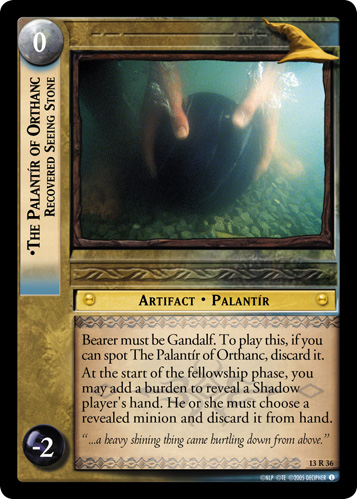 , that discards The Palantír of Orthanc (3R67)
, that discards The Palantír of Orthanc (3R67)
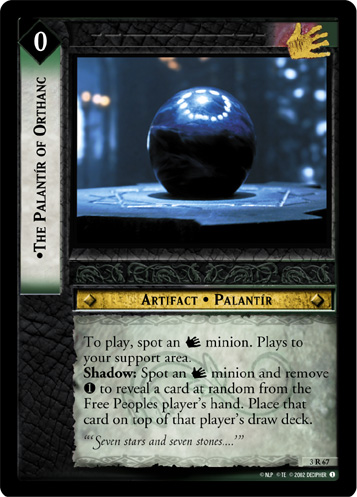 or The Palantír of Orthanc, Seventh Seeing-stone (4R166)
or The Palantír of Orthanc, Seventh Seeing-stone (4R166)
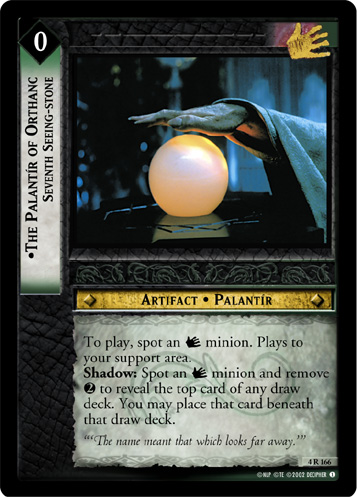 from play and prevents them from being played again as long as Recovered Seeing Stone remains in play.
from play and prevents them from being played again as long as Recovered Seeing Stone remains in play.
Further confusing things, there's a fourth card representing the same orb, Seeing Stone of Orthanc (9R38)
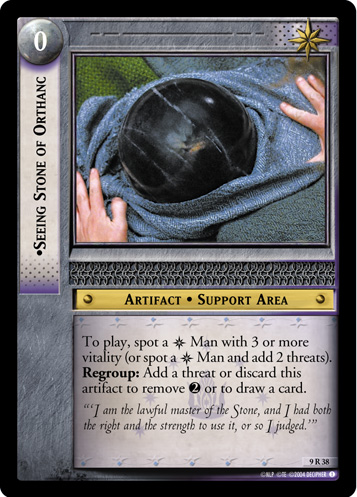 . However, this card does not have the Palantír keyword, nor does it have the same unique persona, so it's possible to have it in play at the same time as any of the three versions of the Palantír of Orthanc.
. However, this card does not have the Palantír keyword, nor does it have the same unique persona, so it's possible to have it in play at the same time as any of the three versions of the Palantír of Orthanc.
Two other seeing stones appear in this game: Seeing Stone of Minas Anor (9R37)
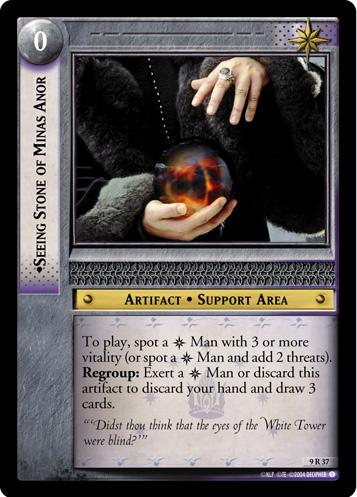 and Ithil Stone (9R+47)
and Ithil Stone (9R+47)
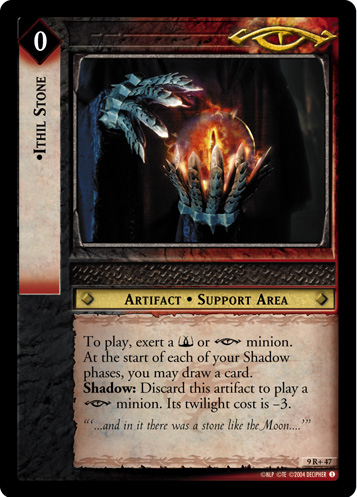 . However, neither of these cards have the Palantír keyword either.
. However, neither of these cards have the Palantír keyword either.
See Also
- Orthanc-stone (for this particular Palantír stone) and Palantíri (for the network of seeing stones) at Tolkien Gateway
| Loaded Keywords | ||
|---|---|---|
| Numeric | Decipher | Damage + X • Defender + X • Ambush X • Hunter X • Toil X |
| Non-numeric | Decipher | Aid • Archer • Enduring • Fierce • Lurker • Mounted • Muster • Roaming • Sanctuary • Ring-bearer • Unhasty |
| Hobbit Draft Game | Cunning | |
| Item Class | Decipher | [Classless] • Support Area • Armor • Brooch • Box • Bracers • Cloak • Gauntlets • Hand Weapon • Helm • Mount • Palantír • Phial • Pipe • Ranged Weapon • Ring • Shield • Staff |